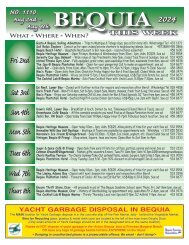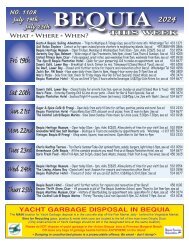Caribbean Compass Yachting Magazine - February 2021
Welcome to Caribbean Compass, the most widely-read boating publication in the Caribbean! THE MOST NEWS YOU CAN USE - feature articles on cruising destinations, regattas, environment, events...
Welcome to Caribbean Compass, the most widely-read boating publication in the Caribbean! THE MOST NEWS YOU CAN USE - feature articles on cruising destinations, regattas, environment, events...
You also want an ePaper? Increase the reach of your titles
YUMPU automatically turns print PDFs into web optimized ePapers that Google loves.
Emergency Offshore?<br />
COMMUNICATIONS CAN HELP!<br />
by Joan Conover<br />
When sailing to or from the <strong>Caribbean</strong>, or within the region, keep in mind that while<br />
emergency communications devices can be lifesaving, the state of technology changes<br />
frequently with upgrades and updates. This article is written to provide a general overview<br />
of the overarching marine emergency communications systems that communicate<br />
messages from those devices; in-depth description is beyond a simple article.<br />
This article is about the network of communications we use as private mariners,<br />
and the communication systems we depend on in emergencies. Since new devices<br />
come on the market daily, understanding the actual emergency communication<br />
process established for offshore vessels by international agreement is critical.<br />
If you travel in international waters to Canada, Mexico, Bahamas, the British Virgin<br />
Islands or practically anywhere else, a Maritime Radio Vessel station license is<br />
required to use Marine VHF and SSB. Additionally, if you travel to a foreign port, you<br />
are also required to have a valid operator’s certificate and Marine Mobile Service<br />
Identity Number issued by your home country.<br />
Your Marine Mobile Service Identity number: MMSI<br />
A nine-digit Marine Mobile Service Identity (MMSI) number<br />
is unique to your vessel, and should be the same for all your<br />
transponder devices and registrations. This number is in your<br />
Single Side Band (SSB) radio, Very High Frequency (VHF)<br />
radio and Automatic Information System (AIS) systems, and<br />
is a part of your Emergency Position Indicating Radio Beacon<br />
(EPRIB) registration — a critical part. New-to-you boats/<br />
devices require either installation of your MMSI number or<br />
owner transfer of the MMSI number to the new owner.<br />
“Can I transfer this MMSI and SSB license over to me on a<br />
US flagged boat?” Sorry, no “transfer.” The previous<br />
American owner must cancel his or her FCC license on the<br />
vessel you just bought. You will then need to obtain a new<br />
ten-year FCC Ship Station license, which will include a new<br />
MMSI number. You can review the process at wireless.fcc.<br />
gov. (Transfer processes may vary from country to country.)<br />
Your registration of your devices with the appropriate<br />
agency for EPIRB, personal locator beacon, AIS, and VHF<br />
devices with a single MMSI for all devices is critical if the<br />
following systems are to work correctly. And keeping devices<br />
re-registered prevents them from aging out of database<br />
systems, which impacts rescue. Your MMSI itself does not<br />
expire; it does not require re-registration.<br />
All captains should keep devices updated and tested prior<br />
to each voyage. Make sure that your registration is current<br />
with your MMSI number, and have emergency communication<br />
and response plans and training for crew.<br />
The satellite-based rescue system: COSPAS-SARSAT<br />
The overarching satellite-based rescue system is called<br />
COSPAS-SARSAT. It is an integration of onboard commercial<br />
and military communication devices linked to satellite<br />
tracking systems, which then network to a series of<br />
international onshore stations. Our private vessels’ devices<br />
utilize this network, sending signals via various emergency<br />
messages. The diagram in Image 1, from the United States<br />
Coast Guard, illustrates the flow of data; note there are several steps, from alert, to<br />
satellite, to shore, to various countries for action. Any issue with registration or poor<br />
signal due to low batteries can cause delay or even notification failure.<br />
The Global Maritime Distress and Safety System: GMDSS<br />
The Global Maritime Distress and Safety System (GMDSS) generally applies to all<br />
ships over 300 gross tons and over on international voyages. However, GMDSScompliant<br />
systems may be carried on private pleasure craft too.<br />
Commercial and military vessels (and private yachts within VHF range) all<br />
participate in GMDSS, which is a key part of marine rescue. This includes search<br />
and rescue satellite-aided tracking (SAR-SAT/COSPAS-SARSAT), which utilizes<br />
EPRIB and Personal Locator Beacon (PLB) alarms.<br />
In addition, there are the satellite voice system INMARSAT and a newly announced<br />
GMDSS IRIDIUM satellite service utilizing special terminals. This new system also<br />
provides the ability for vessels in distress to talk directly to local regional control center<br />
(RCC), and can be used by non-commercial vessels separate from a full GMDSS system.<br />
Emergency Position Indicating Radio Beacon: EPIRB<br />
Another device used for marine emergency notification, the Emergency Position<br />
Indicating Radio Beacon (EPIRB), transmits two signals constantly until either out<br />
of battery power or turned off. One signal is a GPS-supported 406 MHZ (digital to<br />
satellite) tracking signal. The other is a 121.5 MHZ analog homing signal that will<br />
alert all high flying commercial and military aircraft in your vicinity. Basic<br />
information such as your MMSI number and GPS location, date and time are part of<br />
the message package. The homing signal allows nearby GDMSS-equipped ships and<br />
aircraft to zero in on a vessel in distress.<br />
Understanding that there are two transmission systems is critical. The transmitter<br />
should be with the people, not the vessel.<br />
Very High Frequency Digital Selective Calling: VHF DSC<br />
Very High Frequency Digital Selective Calling (VHF DSC) is a line-of-sight VHF<br />
system utilized world wide for emergencies. The Automatic Information System (AIS,<br />
see below) and VHF can share the same antenna system; the frequencies used are<br />
separate but still VHF.<br />
Most often your primary source of seagoing help will be the ship or yacht that’s<br />
closest to you. A VHF DSC distress call can bring help at sea very quickly from boats<br />
in your vicinity. When you initiate an automated VHF DSC distress call by pushing<br />
the red button on your VHF radio, every line-of-sight VHF-equipped vessel within 25<br />
to 30 nautical miles will receive a loud alarm signaling your distress call complete<br />
with your MMSI, boat name and your precise latitude and longitude, and will be<br />
close enough for voice communication. Your VHF radio watches on Channel 70 for<br />
acknowledgement from a nearby boat. If acknowledgement is received, you use<br />
Channel 16 to describe your emergency. If no acknowledgement is received, the<br />
alarm continues to be sent every four minutes.<br />
As most boats have VHF radio, the addition of DSC has offered an even broader<br />
messaging capability for vessels in distress. All consumer-grade marine VHF radios<br />
sold since 1998 are DSC equipped. The only drawback is that VHF is a line-of-sight<br />
transmission, dependent on antenna capabilities of both ships and shore station,<br />
and ship’s power. It does increase the number of vessels who can receive an<br />
emergency broadcast, due to the greater numbers of shore- and satellite-linked<br />
vessels to transmit the alert to the larger systems.<br />
The Automatic Information System: AIS<br />
Another system also on both private yachts and commercial vessels, the Automatic<br />
Information System (AIS), provides vessels with local marine traffic information as a<br />
transponder sending MMSI number/boat name and GPS location. AIS is supported<br />
by local line-of-sight transmissions, creating a local data bubble linked by VHF<br />
transmission. Some devices can also support satellite transmission, called S-AIS, or<br />
satellite-linked AIS with VHF to line-of-sight vessels. Depending on the equipment/<br />
device, a system may be only VHF linked or both VHF and satellite linked.<br />
Boats with AIS see each other in their shared VHF-created data bubble (see Image<br />
2); vessels (usually commercial) with S-AIS see the local bubble and can share this<br />
information more globally back to shore-based information data systems. A<br />
commercial venture, MarineTraffic, utilizes a combination of shore-based AIS data<br />
sites, as well as satellite-based data, to collect and provide an AIS view of worldwide<br />
AIS enabled vessels as they voyage.<br />
For emergencies, there are also EPRIB devices with AIS sending emergency signals<br />
to both systems. This is an addition that could shorten alert time with both<br />
technologies involved.<br />
Some newer, lower-cost features<br />
Some of the newer, lower-cost features for vessels are the Satellite Locators, the<br />
Garmin InReaches, SPOT and other devices entering the market for private<br />
citizen use on water and on land; and the onboard man overboard systems<br />
(MOA), which can be a combination of smart phone apps/local WiFi and/or PLB<br />
and MOA combinations. Last but not least are voice and data messaging systems<br />
such as SSB radio and satellite-based phones/data systems such as IRIDUM GO<br />
and Globalstar.<br />
Most of these commercial locator systems also provide an emergency alert capability<br />
or SOS button. For most, as a service provided by the vendor or added-on for a fee,<br />
a global vendor, Garmin’s GEOS, provides emergency rescue coordination and<br />
SOS/911 monitoring through their dedicated International Emergency Response<br />
Coordination Center. GEOS can be added to your device, so when the SOS button is<br />
pushed a mission control center is notified. This is separate from your EPRIB — it’s<br />
a commercial service, paid for yearly in the case of GEOS. As a service covering 140<br />
countries, it will use your registration data to coordinate your rescue response with<br />
government rescue coordination centers. This service can be expanded to cover<br />
international search and rescue costs, and in some cases medical evacuation: a<br />
reasonably priced service to be aware of if you are going offshore.<br />
In the final review of systems for offshore and near shore devices used for<br />
emergencies, all require registration, maintaining, testing, and strong batteries —<br />
either ship’s power or internal batteries. All require an understanding of how they<br />
work, and the way to deploy and test them.<br />
Your safety at sea can be dependent on many factors in addition to seamanship,<br />
such as making sure you provide the basic emergency systems for your vessel, as<br />
well as keeping the registration needed for search and rescue up to date. And as new<br />
devices are developed to utilize rescue networks, captains will select what will work<br />
for their cruising plans.<br />
FEBRUARY <strong>2021</strong> CARIBBEAN COMPASS PAGE 15

















